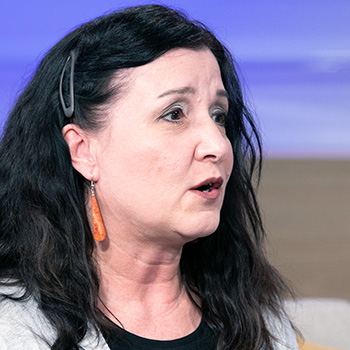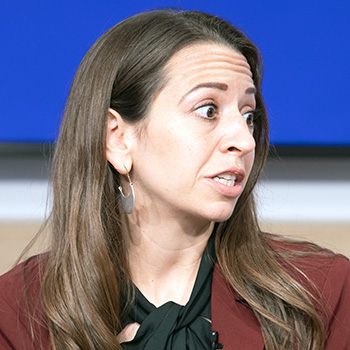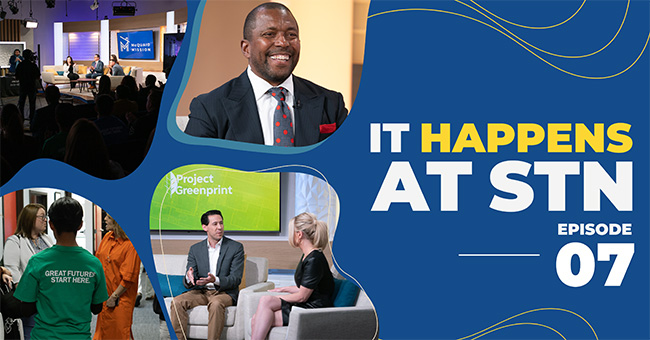Solving systemic homelessness in the Phoenix area and getting people into the housing they need is simply too big of a job for a single person or single organization. So, when it comes to addressing big challenges like the housing crisis, building teams is key to dividing and conquering rather than being siloed in a solo mission.
For the McQuaid Mission action panel in April’s episode of It Happens at STN, Human Services Campus CEO Amy Schwabenlender is joined by Valley Leadership CEO Dave Brown and Javelina CEO Catherine Alonzo for an important discussion about how to build coalitions, how to rally groups behind an idea and how to create the appropriate messaging for the mission.
What follows is a transcript of the McQuaid Mission Action Panel taped on April 6, 2023. It has been edited for length, clarity and context.
McQuaid Mission is part of It Happens at STN, a local news hour dedicated to community growth and actionable solutions.
Each month, viewers get exclusive access to issues, solutions and progress related to the fight to end homelessness in Phoenix.
Action Panelists
Amy Schwabenlender
CEO – Human Services Campus
Dave Brown
CEO – Valley Leadership
Catherine Alonzo
CEO – Javelina

Find the willing
It takes a lot of patience to not rush people into things they may not want to do. What we find working, is identifying the coalition of the willing, with a mission or a goal. So, who agrees that everyone deserves an affordable home? Ask those people to work together instead of waiting for everyone that you may want to have around the table to agree.
It’s a bit like analysis paralysis. If people keep asking, “I need this data,” [or] “I need to know this before I agree,” you never get anything done. So we tend to start small just on the [Human Services] campus itself. There are 16 organizations. It’s challenging to get 16 organizations to agree absolutely to any kind of change. So we start with those who are willing.
It’s really about testing and using the spirit of innovation to say, “Let’s test it. Did it work? Did it not work? What do we learn from it?” What we find is when we have success, other people want to join and be part of the success.
Do what you do well
You have to be honest with each other. You have to have a strong ability to expose your vulnerabilities. The campus is a good example of admitting what your strengths are and what your strengths are not. Do what you do best. Don’t attempt to be everything to everyone in this homeless services space.
No one organization can address the holistic array of services that an individual needs. If you can put that aside and focus on what you do best and not worry about taking credit, the credit will come to everybody, which I believe spurs more action.

Same song, different stanzas
People who care about an issue, want to be part of its solution. So as the housing crisis started to increase rapidly two [or] three years ago, a group of coalition members of the willing decided to get together and say, “Instead of doing various campaigns and talking about housing differently, let’s do one thing.”
I credit Joan Serviss, who is now our director, as often as I can. She said, “Hey, let’s get one song that we can sing from. We may have different stanzas.” When you look at the housing continuum from homelessness to home ownership, there are definitely different ways to talk about it. If we’re all generally singing the same song and we’re all generally interested in doing something about it, let’s do that.
Rally behind an idea
We rallied and created Home is Where it All Starts, which is a very thoughtful message put together by Catherine [Alonzo] and her team. [It is] a core group of all sorts of leaders in the housing space who said, “Yeah, we’re gonna meet every single week to figure out how we get people to rally behind this idea that everyone needs a home.”
There’s maybe some argument around, does everybody have to have a home? If not, at least we can accept the fact that everyone needs a home. How can we get people to connect to that idea and say, “I’m willing to do something about it and I have some standard language to talk about it.”
[I’m] just super grateful for Catherine, her team, her thinking of when we talk about partnerships, we’re not going to be able to get everyone on board behind something. But, if we can get enough people singing some part of a song, we can start changing minds, hearts, policies, to get where we need to be; where everyone along that continuum of home can get the home they need.

Targeted messaging
Anytime that you are developing any kind of messaging, you really want to be thinking about the target audience. So often when we are telling a story, we think about what will resonate with us. But if you are in a room, chances are you are not representative of the target audience. We are really trying to bring people along who haven’t necessarily heard of our messages before.
One of the most important things is, how do we make it easy for them to take action? We knew that when we were developing language for this campaign, it had to be accessible, it had to be easy to understand, and it had to relate to our own personal experiences.
Paradigm shift
The phrase affordable housing can so often be a barrier because it has become synonymous with a type of housing. People hear affordable housing and they think a certain thing. And there are stereotypes and stigmas attached to that kind of housing. That can be a real barrier in the way of developing affordable housing in neighborhoods.
So one of the phrases that we are including in the campaign is “affordable rents and mortgages.” Because when you think about affordable housing, you think, “Oh, that’s for other people, that’s not for me.” Whereas the concept of being able to literally afford your rent or your mortgage is something that we all relate to, across the whole spectrum.
So the cornerstone of the campaign really is telling this story in a way that really emphasizes [that] this is something that impacts all of us. We all need a home, we all need to be able to afford it. It needs to be able to meet the needs that we have for us and our families.




